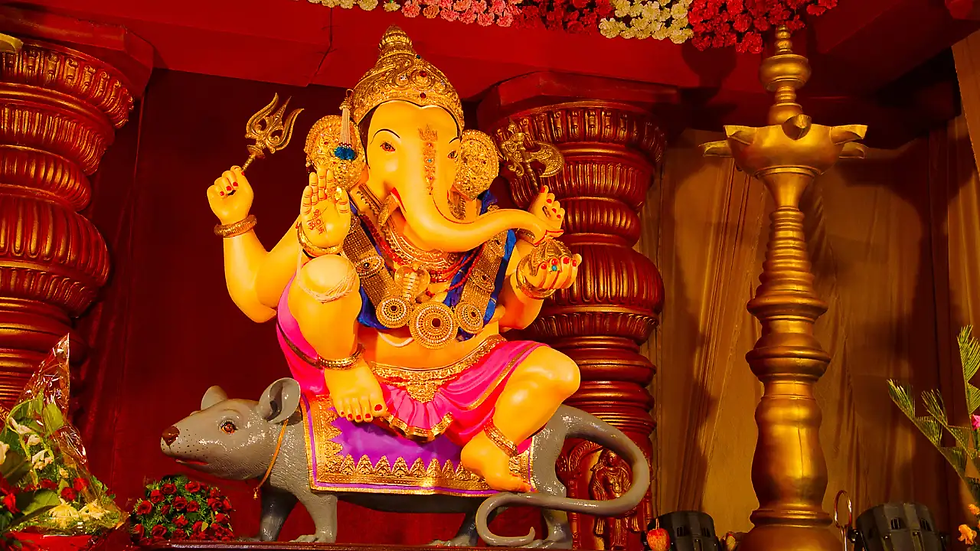Why Did Lord Ganesha Choose a Mouse as His Vahan? The Hidden Significance Revealed!
- Sonali Singh
- Sep 3
- 3 min read
The moment we picture the idol of Lord Ganesha with his companion Mushakraj—the mouse or Vahan—the only question that often strikes the mind is: Why a mouse?
When we see an idol of Lord Ganesha with Mushakraj, the mouse who is his vehicle, we often wonder why he chose a mouse. This interesting image appears in many temples and homes. It has a deep meaning connected to Hindu stories and spiritual teachings. In this article, we will share the story behind this special connection. We will also explain the important lessons from ancient scriptures that still inspire people today.

The Legend of Krauncha: From Musician to Mouse
According to the Ganesha Purana, there was once a heavenly musician named Krauncha. He was famous for his beautiful music in the divine courts. But during one performance, Krauncha accidentally stepped on the foot of a respected sage named Rishi Vamadeva.
Sages in Sanatan Dharma are embodiments of divine knowledge, and insulting a Guru-like Sadhu brings grave consequences. Enraged, Vamadeva cursed Krauncha to become a giant mouse. The transformation wasn’t just physical—it was spiritual. Krauncha, now a monstrous mouse, lost all sense of control and began wreaking havoc on forests, ashrams, and fields.
Eventually, the mouse destroyed the ashram of Rishi Parashar, who was residing under the protection of Lord Ganesha at the time. To restore balance, Lord Ganesha intervened. With his divine weapon, the Pāśa (noose), he lassoed the giant mouse and brought it to submission.
The mouse felt very sorry and bowed down to Lord Ganesha. He asked for forgiveness. Lord Ganesha, full of kindness, gave the mouse a choice. He could become his vehicle forever. The mouse accepted humbly. The mouse, touched by this grace, humbly accepted. And from that day on, Krauncha became Mooshika, the faithful vehicle of Lord Ganesha.
यथा कर्म तथाफलं।
As the action, so the result.

Spiritual Significance: Mastering the Mind
This tale from the Ganesha Purana is not just a story — it’s a lesson for all sadhaks walking the path of Sanatan Gyan.
In Hindu philosophy, the mouse represents the restless mind. Thoughts are like hyperactive children at a fair, jumping around seeking more things, trying to grab a hold of everything. Unchecked impulses are like these children, always rushing to elusive places, tangled within dark conflicts between themselves. Yet Lord Ganesha, the master of wisdom, rides a mouse in his iconography which expresses ability to reign in ungovernable restlessness of the mind and ego.
"योगेन चित्तस्य पदेन वाचां मलं शरीरस्य च वैद्यकेन।"
Translation: "By yoga, the mind is purified; by speech, the words are refined; by medicine, the body is cleansed." (From Yoga Sutra – Sage Patanjali)
By choosing the mouse, Ganesha shows that even the wildest and smallest parts of ourselves can be controlled with wisdom and humility.

Why a Mouse?
In agrarian societies of ancient India, mice were symbols of destruction. They destroyed crops, spread diseases, and lived in hiding. Choosing such a creature as a vahan was revolutionary. It sends a powerful message:
Even the smallest and most destructive can find purpose in the divine order. Even the ego, when surrendered, can serve the soul.
"विनायकः सर्वसिद्धिप्रदः स्मृतः।"
Translation: "Vinayaka (Ganesha) is remembered as the one who grants all success." - (Ganesha Purana, Chapter 3)

It is more than a symbol, the mouse is a vehicle of choice for Lord Ganesha, the Pavaka Brahma, for it conveys a profound spiritual teaching. Krauncha and the mouse parable teaches that the most ungovernable aspects of our nature―the ego, the ungovernable passions, and the undisciplined mind―can be mastered, and brought under dominion.
Through wisdom shorn of ego, in all humility, and under divine inspiration, one masters oneself. From the Zohar, seeing Ganesha riding a mouse urges one to appreciate that nothing is too diminutive or too blemished to fulfill some function. In the Sanatan Dharma, every nuance is significant. Ganesha and mouse are also a reminder to clear one’s internal and external chaos, and learn the disciplines of self-control and peace.

Comments